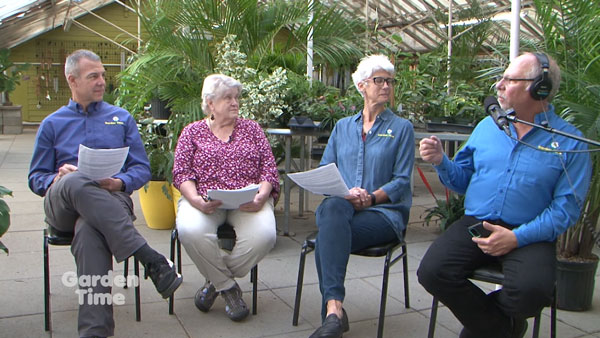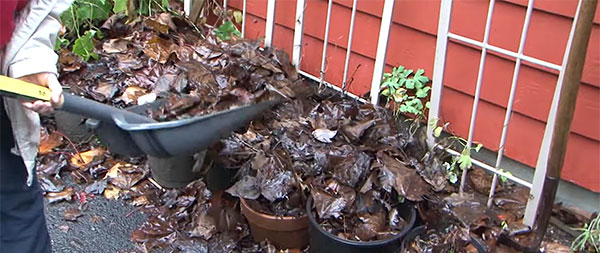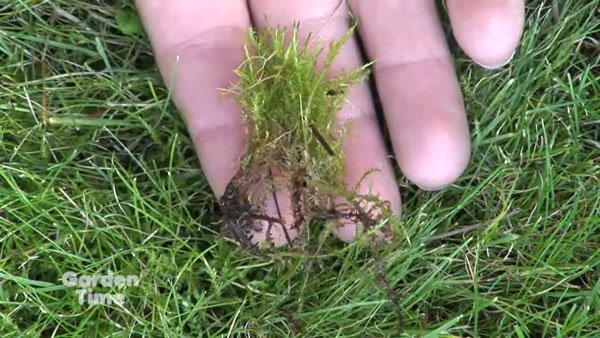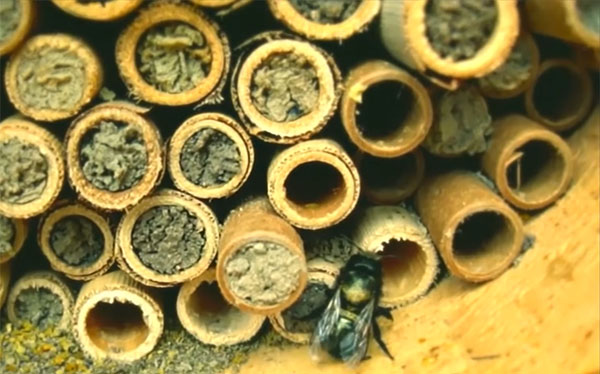|
Season 2 • Episode 20 - October 23, 2023
You may think that fall is a time to
slow down in the garden. The cold breezes and rain
showers have returned and, with the darker days, it is
easy to say that we’ll just wait until March to return
to our outdoor activities. Still, there are a lot of
things that you can do in your garden to help it make
the transition to winter and prepare it for the distant
spring.

Retired
Oregon State University Extension Agent, Jan
McNeilan, joined us again to fill us in on a few of the
projects that we can tackle now between the showers.
She started with clean up. Your vegetable plants and a
few of your other garden plants are now dying back and
you can get rid of the dead and diseased plants in your
garden. If you have diseased plants you will want to
throw them in the garbage. If you put them in your
compost pile they will just return when you spread that
compost out the next spring or summer. You can also walk
around your garden and make some changes now that things
are going to sleep. Moving plants that have gotten too
big or are unhappy in their current location can be at
the top of your list. The outside temps may be cold, but
the soil temps are still pretty warm and the plants will
get a few weeks to acclimate to their new surroundings.
If you are walking around make sure to bring in your
nearly ripe tomatoes. They can be kept on your kitchen
counter and may ripen after a few days. You can also
harvest seeds from flowers and vegetables now, to use in
your garden next spring. You can leave your root crops
in the ground for now and pull them out as you need them
in the kitchen. In fact, some root vegetables, like
carrots, can get a little sweeter after they have
experienced a frost. Fall is also a great time to plant
some of those cold-hardy cole crops that will slowly
ripen over the winter. Of course, winter gourds and
squashes can also be picked and stored in a cool, dry
area of your garage so you can enjoy them later too.

Clean up can also take many forms. You can still be a
little messy and leave the seed heads from your old
perennials for the wildlife to enjoy and piles of stuff
around the garden to provide shelter for the smaller
critters in your garden. Your leaves can also be used to
provide a mulch covering for your garden beds instead of
raking them up and sending them to the curb for pick up.
Those old leaves are like gold to your plants, helping
to replace the nutrients in your soil. You can also
plant a cover crop to help restore nutrients to your
garden. Cover crops, like clovers, peas and vetch, are
called ‘green mulch’ for the natural elements they
return to the soil.

If you have a lawn that needs to be rejuvenated you have
to do it before it gets too cold. The seed needs to be
warm and kept moist to germinate and grow, but if you
get a chance it could help you start the spring season
with some new grass to enjoy. You can also add a fall
fertilizer to your lawn now. The fall mixes are
formulated to help strengthen roots for a quicker and
healthier start to your grass for the spring. You can
also do a soil sample now too. That will tell you if you
even need to use a fertilizer in your garden, or if you
have enough nutrients there already.
Fall can be a time for pruning, too. Remove the dead,
diseased and crossing branches to prevent them from
falling and damaging your garden or home in the winter.
If you are unsure about what to cut and where to cut,
contact a certified and bonded arborist. If you’ve had
your trees thinned a few years ago, it may be time to do
it again. You can also get your schedule together for
your late winter dormant spraying. Different trees and
shrubs may require spraying at different times. Find out
what your plants require and then put dates in your
calendar to remember to spray at the correct time. You
can also do a first cut to your roses in the fall.
Cutting them down to waist high will keep them from
whipping around in the wind. Your next big ‘hard’
pruning on your roses will be in February or March.
Pest control can also take place now, especially when it
comes to slugs in your garden. Baiting for -- and
getting rid of -- slugs will prevent them from laying
eggs that will create slug problems in the spring. The
reduction of the population now will mean fewer slugs
five months from now.

After a break we had a bunch of garden myths that Jan
also wanted to talk about. One of them deals with the
use of lime in the garden. Unless you know that you have
a problem with pH in your soil, there is a myth that
using lime in your lawn will help control moss. It
doesn’t. Moss thrives in our climate due to a couple of
factors: shade and moisture. Lime doesn’t do much to
deter that. However, adding lime or calcium to your
tomatoes when planting them in the spring can help
prevent ‘Blossom End Rot’. The lime will sweeten your
soil, making it less acidic. On the other end of the
spectrum are the people who want to add wood chips or
pine needles to their soil to help acid-loving plants.
That doesn’t work well either. It is best to use a
product that contains a more concentrated mix of
minerals and nutrients to help with that. What about
controlling the height of a tall tree by topping it? If
you top a tree it won’t stop it from growing. What may
happen is that you may reshape the tree away from its
natural form and that may cause problems in the future.
This may be caused by the tree growing in a different
direction, creating weak branching, or a weaker
structure.

Another myth involves compost. Can you add too much? Not
really, if you can incorporate it into your garden beds,
being careful to not pile it up around the base of your
trees and shrubs. If you pile it around the trunk of
plants it will cause rot to the base. Also, do bee
houses benefit bees? The short answer is yes. However, a
majority of your native bees are ground dwellers and so
you should be aware of that and try to keep a few spots
in your garden a little messy to avoid disturbing their
homes. The next one was about tree roots. Some think
that tree roots extend out only to the drip line of the
tree. The drip line is the line marking the extent of
the foliage from a tree. The edge of the tree where
water drips down. However the root system can grow much
further than that. This can determine where you should
water and fertilize your plants. One of the most popular
myths involves Epsom salts and using it on your plants,
including tomatoes and roses. Does it work? Possibly. It
is mainly magnesium and your plants may benefit from
using it in your garden, or they may not. If you are not
throwing an excessive amount of Epsom salts out on your
plants, and it isn’t causing any harm, then continue to
do it if you think it works. Remember some home remedies
can do harm to your garden if they are untested.
Commercially available products generally have to be
tested to be considered safe in their recommended
dosages. That is why they are considered safe and
effective for use in your garden.
Now, there are many more myths out there and if you ever
have questions about garden myths or tall tales, contact
your local university sponsored Extension Service or
local garden center help desk.
We finished this podcast talking about our upcoming
Garden Time tour to Spain and Portugal in September and
October of 2024. If you would like to join us on this
incredible trip,
check
out our website and click on the little airplane at
the bottom of the page.
Or go directly to the tour page, here.

PODCASTS
2022
• Return to Current Year Podcast List
 |